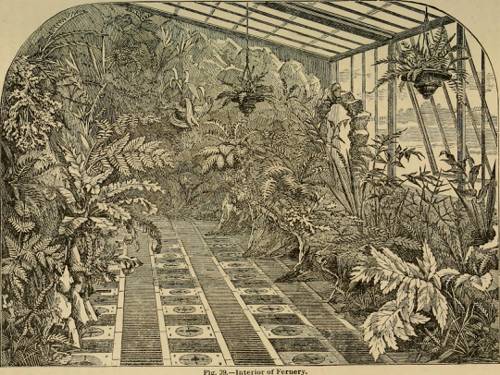
FAQ About Indoor Plant Epigenetics and Growth Behavior

What is plant epigenetics?
Plant epigenetics is the study of heritable changes in gene expression that do not involve changes to the underlying DNA sequence. These changes can affect how plants grow, develop, and respond to environmental factors by altering gene activity without altering the genetic code itself.

How does epigenetics affect indoor plant growth?
Epigenetics can significantly impact indoor plant growth by controlling gene expression in response to environmental stimuli such as light, temperature, and water availability. This can influence traits such as flowering time, height, and stress resilience, helping plants adapt to changes in their environment.

What are some examples of epigenetic changes in indoor plants?
Examples of epigenetic changes in indoor plants include variations in leaf shape and size, flowering timing alterations, and improved stress tolerance. For instance, plants exposed to prolonged periods of drought may adapt through epigenetic modifications, enhancing their ability to withstand dry conditions in the future.

Can indoor plants pass epigenetic changes to offspring?
Yes, indoor plants can pass epigenetic changes to their offspring through a process called epigenetic inheritance. This means that adaptations made by the parent plant in response to environmental stresses can be inherited by the next generation, potentially enhancing their survival and adaptability.

How do environmental factors influence plant epigenetics?
Environmental factors such as light exposure, temperature fluctuations, water availability, and soil nutrients can trigger epigenetic changes in plants. These factors can modify the expression of genes involved in growth, development, and stress response, thus influencing overall plant health and adaptability.

What role does DNA methylation play in plant epigenetics?
DNA methylation is a key epigenetic mechanism that involves adding a methyl group to DNA, usually at cytosine bases. This modification can repress gene activity and is involved in regulating growth, development, and stress responses in plants, allowing them to better adapt to their environment.

Are there any benefits of studying epigenetics in indoor plants?
Studying epigenetics in indoor plants can help improve understanding of their growth behaviors and resilience. It can lead to the development of more robust plant varieties with enhanced adaptability to variable indoor conditions, ultimately benefiting plant breeders and horticulturists.

How can stress exposure lead to epigenetic changes in plants?
Stress exposure, such as drought or extreme temperatures, can induce epigenetic changes by altering gene expression patterns. This enables the plant to activate stress-responsive genes, enhancing tolerance and promoting recovery from adverse conditions. Over time, these changes can become stabilized and passed on to future generations.

What is histone modification, and how does it relate to plant epigenetics?
Histone modification involves chemical changes to the proteins around which DNA is wound. These modifications can influence gene expression by altering chromatin structure, making it easier or harder for genes to be transcribed. This process plays a crucial role in regulating plant growth and response to environmental changes.

Can epigenetic changes in plants be reversed?
Certain epigenetic changes in plants are reversible, depending on the mechanism involved. For instance, DNA methylation patterns or histone modifications can revert under different environmental conditions or through developmental processes, allowing plants to fine-tune gene expression as needed.

How do biologists study epigenetic changes in plants?
Biologists study epigenetic changes in plants using various techniques such as bisulfite sequencing to assess DNA methylation, chromatin immunoprecipitation to analyze histone modifications, and RNA sequencing to evaluate changes in gene expression levels. These tools help elucidate how plants adapt to changing environments at the molecular level.

What is the difference between genetics and epigenetics in plants?
Genetics involves the study of the genetic code, DNA sequences, and heredity, focusing on how traits are passed from one generation to the next. Epigenetics, on the other hand, studies changes in gene expression that do not involve alterations in the DNA sequence, often in response to environmental factors, affecting how plants grow and develop.

How does epigenetics influence the adaptability of indoor plants?
Epigenetics enhances the adaptability of indoor plants by enabling quick responses to environmental changes without the need for genetic mutations. These rapid adjustments help plants maintain optimal growth and development even under fluctuating indoor conditions, such as fluctuating light or temperature levels.

What research is being done on plant epigenetics?
Research on plant epigenetics is focused on understanding how epigenetic mechanisms help plants respond to environmental stresses, how these changes are inherited, and their impacts on plant breeding. Studies are exploring the potential of manipulating epigenetic marks to develop crops with improved traits.

How do epigenetic changes affect plant breeding?
Epigenetic changes play an important role in plant breeding by providing additional means to enhance desired traits. Understanding these changes allows breeders to select plants with specific adaptations or stress responses, potentially leading to the development of more resilient and high-yielding crop varieties.

Are certain indoor plant species more prone to epigenetic changes?
Some indoor plant species may exhibit more pronounced epigenetic changes due to their higher sensitivity to environmental fluctuations. Species with shorter life cycles or those frequently exposed to stress conditions may have more dynamic epigenetic responses to adapt quickly.

What are the potential applications of plant epigenetics in agriculture?
Applications of plant epigenetics in agriculture include developing crop varieties with enhanced stress tolerance, improved nutritional content, and better growth efficiency. By leveraging epigenetic insights, farmers and plant breeders can cultivate plants that withstand environmental stresses more effectively, ultimately increasing productivity.

Can indoor plant care practices influence their epigenetic traits?
Indoor plant care practices, such as watering schedules, light exposure, and nutrient management, can influence the epigenetic traits of plants. Proper care can lead to healthier plants with more robust growth and improved ability to adapt to varying indoor conditions.

How does chromatin structure play a role in plant epigenetics?
Chromatin structure, which comprises DNA and histone proteins, influences plant epigenetics by affecting the accessibility of genes for transcription. Changes in chromatin structure, through epigenetic modifications like histone acetylation or methylation, can modulate gene expression patterns in response to environmental stimuli.

Is there a link between plant epigenetics and plant immunity?
Yes, plant epigenetics is linked to plant immunity, as epigenetic modifications can regulate genes involved in defense responses. These changes can enhance a plant's ability to resist pathogens and recover from infections by modulating immune-related pathways, directly impacting the plant's health and survival.
